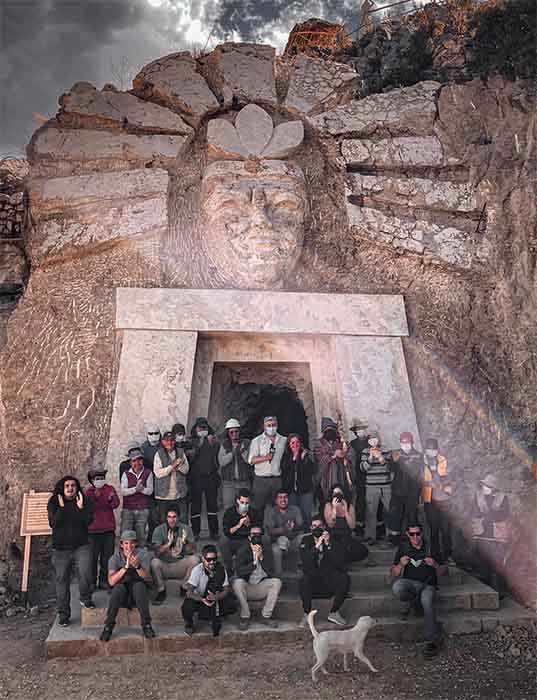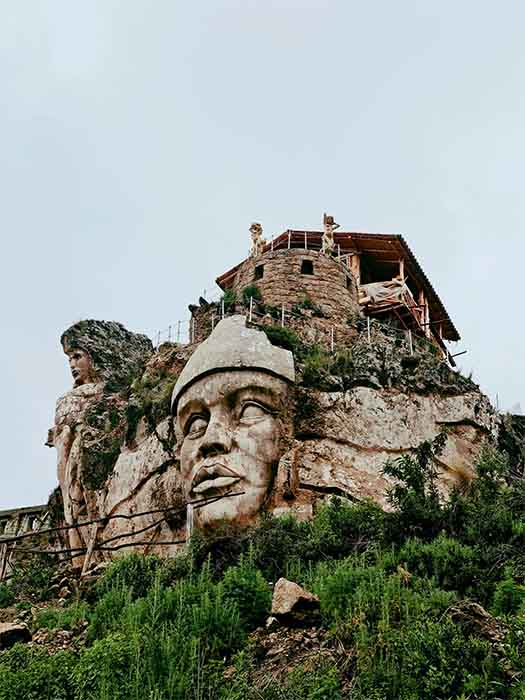
Andean Gods Emerge From the Rock in Peru’s Mythological Sculpture Park!
A sculptor in Peru has assured the future for a range of ancient Andean gods, spirits and myths, by carving them into the face of a mountain just north of the famous ancient tourist city of Cusco.
Cusco near the Urubamba Valley of the Andes mountain range in southeastern Peru, is the ancient capital of the “ Tahuantinsuyo,” or ancient Inca Empire. While this legendary high altitude stone city attracts hundreds of thousands of tourists from all over the world to see its magnificent buildings and streets, it now has a new attraction in the making: Apukunaq Tianan or the " Abode of the Andean Gods.”
Located in Senk, a community of the Poroy district, about 40 minutes by car from Cusco, Apukunaq Tianan features sculptures of Andean gods and figures from various Inca creation myths. While the new attraction is still under construction the public are already flocking to what The Vale Magazine call “a fun and fascinating outdoor recreation space.”
Created by Cusco sculptor Michael de Titan the new artworks are similar to the Mt. Rushmore monument in the United States, just much smaller in scale, with each sculpture work ranging from between 49 and 56 feet (15 and 17 meters) in height.

Two of the sculptures in the process of being created on the mountainside at Senk, near Cusco, Peru. (Corporacion Monteagudo)
Apukunaq Tianan: A Modern Home For Andean Gods and Myths
Michael de Titan’s celebration of Andean culture merges art and nature “just like the ancient Inca did.” Therefore, Apukunaq Tianan is like a royal palace of Andean deities and spirits with its own private library of creation stories.
Pachamama or “Mother Earth” is represented at the new site, who was/is the deity who presides over agriculture, controlled earthquakes, and rain. This god was associated with feminine principals relating to the spirit of the Earth.
- Study of Ceramics Provides New Thinking on Origins of First Peruvian Empire
- Peruvian Archaeologists Unearth Silver Artifacts, a Massive Temple and an Astronomical Observatory Near Cusco

The Chinese music band Laguna Pai on their visit to the Apukunaq Tianan Andean gods sculpture park, north of Cusco. (Apukunaq Tianan)
While Pachamama was associated with the fertile field and rivers on the sides of mountains, the mountains god, or “ Apu Guardian” governed mountain tops and consorted with the sky gods. A stunning Apu cliffside sculpture is naturally featured in the new sculpture park.
Also represented at the majestic new tourist attraction is Puma, one of the sacred animals of the Andean trilogy of the condor, the puma and the snake or serpent. Puma represented Earth while the serpent represented the underworld, and the condor was associated with the heavens.
The Andean creator god Viracocha is also immortalized in stone at Apakunaq Tianan. This chief deity of Inca mythology is believed to have emerged from Lake Titicaca where he created the entire universe, and everything in it, before vanishing to the east.
Also chiseled in stone in Apakunaq Tianan’s hall of Inca mythological fame, is the last Sapa Inca, "Tupac Amaru," and mixed in with these massive sculptures are smaller carvings made of wood and stone.

Another of the fantastical Andean god sculptures at Apakunaq Tianan with a log house gallery on top. (Apukunaq Tianan)
The Ayar Brothers And The Golden Rod Of Cuzco
It is hoped that Apukunaq Tianan will be completed later this year to coincide with the bicentennial year of Peru ’s independence. While each of the sculptures described so far are exceptionally esoteric in nature, there is one that penetrates the veil more so that all the others.
This work represents the myth of the Ayar Brothers. Inca legends in Cusco say that at the end of the great flood which devastated the land of the mountain “Tampu Tocco,” four young brothers with their wives, and ten “ayllus” (Inca family groups) ventured in search of fertile lands where they could settle.
- Ancient Andean Genes Reveal DNA Continuity Amid Cultural Clashes
- Beyond the Mists of Time: The Mysterious Timoto-Cuica Culture of the Venezuelan Andes
After a series of tribulations, the only survivor of the Ayar brothers was Ayar Manco who managed to reach the aforementioned fertile land. There, he took the golden rod that the sun god Inti had given him, and sank it into the moist earth, where it immediately vanished. Such an occurrence could only mean that the sun god had chosen a special spot and it was there that the city of Cusco was founded.
From this ancient Andean center of agriculture, the “Tahuantinsuyo,” would later expand and become the Inca Empire.
Top image: One of the Andean gods at the Apukunaq Tianan sculpture park, featured on a publicity poster from the site. Source: Apukunaq Tianan
By Ashley Cowie
















Comments
That's so incredible! Ones always reading about historical sculptures but forget about the current ones being made and remembering cultures right now.